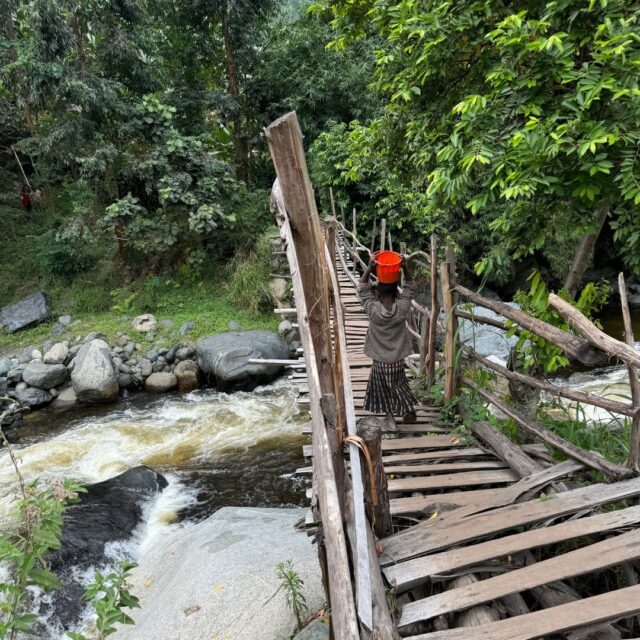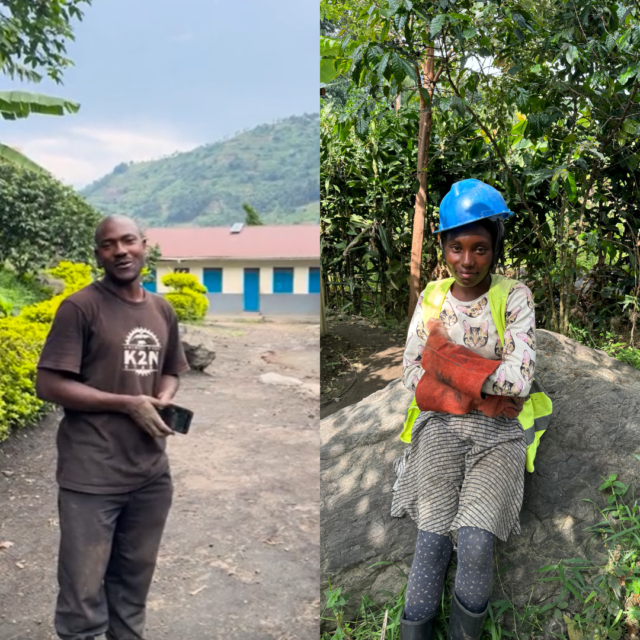Bridging Hope: A Journey of Resilience in Uganda
As a newcomer to Engineers Without Borders USA, having joined the organization just this past March 2024, my recent trip to Uganda was filled with anticipation. This journey to the Kasese district in Western Uganda wasn’t just my first major project visit with EWB-USA; it was a return to a continent that had profoundly shaped my life years ago. As someone who had spent years working at the grassroots level With Peace Corps Zambia, I was eager to see how EWB-USA’s approach would compare in practice, and of course, I couldn’t wait to spend time with community members working on and impacted by the new bridge.

The Bikone community, nestled in the majestic mountains of Western Uganda, faced a daunting root challenge: isolation due to natural barriers. Here, the formidable Mubuku River stood as both a lifeline and a threat to the local people. As I stood on its banks, watching the powerful current capable of moving 8-foot boulders, I was struck by the beauty and the power of the river. In 2020, devastating floods destroyed the bridges connecting Bikone to neighboring areas. Since then, residents have resorted to using precarious log bridges to access schools, healthcare, and markets. The consequences have been heartbreaking, with community members estimating that more than 15 people—mostly women, newborn babies, children, and the elderly—have lost their lives due to flooding and unsafe river crossings. EWB-USA was aware of this need in the community because of a water system our volunteers completed in the community in 2021, which is currently well-maintained and provides fresh, clean water for thousands of people. The need for the bridge was clear, this wasn’t just about constructing a physical structure; it was about reconnecting two communities, the Bikone and Nyakabuha, and ensuring they were involved in every step.
While the bridge in itself is impressive, the length of a football field, what truly made this project special , was the unwavering commitment to putting the community at the center of every decision and action. From the beginning, the Bikone and Nyakabuha communities were an integral part of the planning process. When presented with different bridge designs, the community members chose the option with higher clearance from the river—a decision rooted in their deep respect for the water’s power and their determination to build a lasting solution.
This project was years in the making and involved dozens on stakeholders, including a team of US based transportation engineers from HDR who spent two weeks in Uganda working alongside the local crew to bring it to fruition. The Engineers Without Borders East Africa team was on site everyday for months, promoting local leadership, fostering gender equity, and enhancing technological capacity. This project was funded by one individual, committed to being anonymous, who invests in projects around the world that center communities, insisting on capacity building opportunities within the development project.
One aspect of this project that particularly moved me was its focus on gender parity and providing equal opportunities. We know that when women succeed, we all benefit, and this project has achieved an impressive 50-50 gender balance in its workforce, which will have ripples of impact for years to come. Women traditionally excluded from construction work learned valuable skills like welding and concrete pouring. As I watched these women at work, their confidence and pride were palpable. One woman shared, “I’m not just building a bridge; I’m building a better future for my children.”

As I spent time in the Bikone and Nyakabuha villages, talking to different groups about the bridge, I was struck by the multi-faceted impact:
- A 20-year-old single mother shared, “This opportunity to learn skilled labor and earn wages has changed my situation. I’ve started saving for my child and can afford more essential goods.”
- The Chairman of the Bikone School expressed optimism: “The bridge will positively affect our school, which currently has 750 pupils. We expect this number to grow because of the safe passage it will provide.”
- Women in the village spoke of their fears: “We are afraid of crossing the river to deliver our babies, but this is where the delivery hospital is.” Another recounted a tragic incident from December when a woman lost her newborn due to sudden flooding.
- A community member who donated land for the project proudly stated, “I donated the land because I believe this project will uplift the area. Now, it is not my land, but I am proud to give to this community. We will see growth in this area because of this bridge.”

As my six-day trip came to an end, I found myself reluctant to leave. The beauty and peace of Bikone, with its majestic 360-degree mountain views and roaring river nestled in the valley of several high peaks in the Rwenzori mountains, was captivating, and the energy was electric. The bridge will enable safer access to education, healthcare, and economic opportunities. It’s a symbol of progress, built not just with concrete and steel, but with the hopes, dreams, and labor of these two communities.
This project embodies the ultimate goal of our work at Engineers Without Borders USA: partnering with communities to meet their essential human needs, empowering women, and fostering sustainable development. The bridge is a testament to what we can achieve when we combine technical expertise, local knowledge, and a shared commitment to inclusive development.
Engineers Without Borders USA in partnership with Engineers Without Borders East Africa built a 106 meter bridge above raging Mubuku river in Western Uganda, ensuring thousands will have safe access to healthcare, economic and educational opportunities. You can learn more about this effort! Check out our previous blog post about how this project came to be or watch the video below to gain a deeper understanding.
